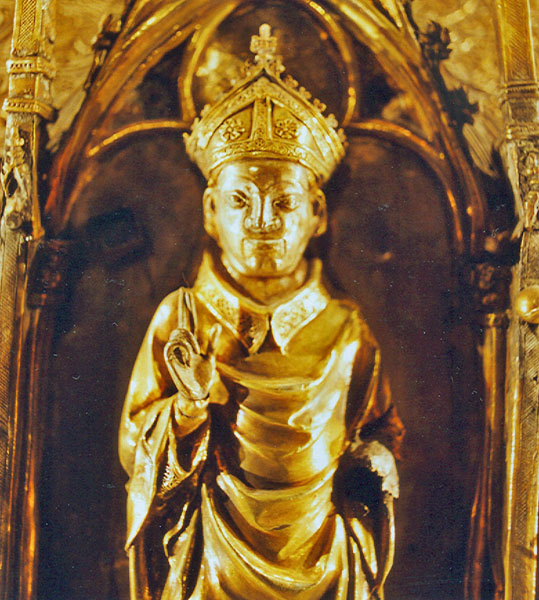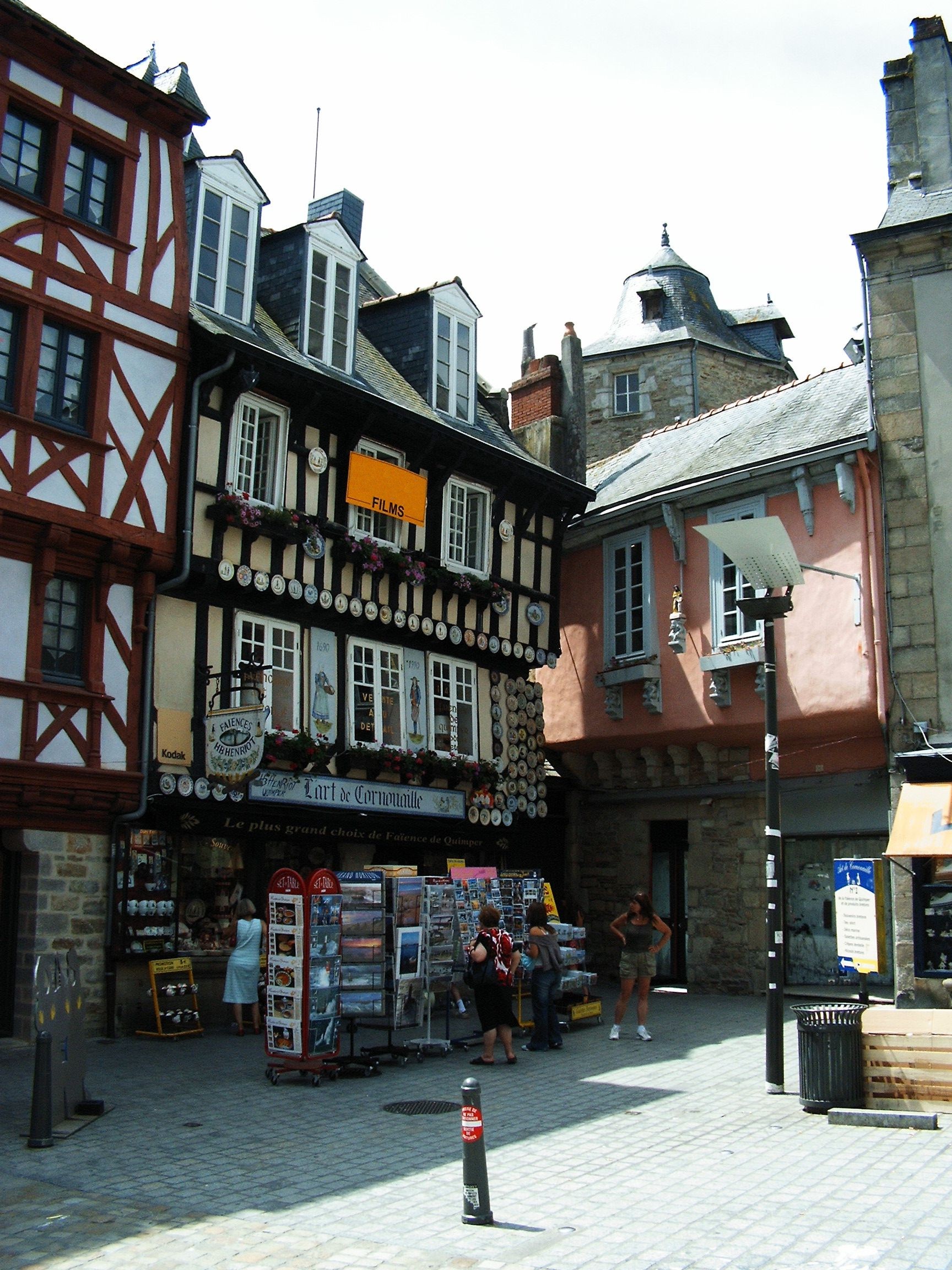|
Jacques Jules Bonnaud
Jacques Jules Bonnaud, SJ (also James Julius Bonnaud; 1740 – 1792) was a Haitian-born French Jesuit priest who, with several others, was assassinated in the September Massacres during the Reign of Terror as part of the French Revolution. He was likely the first Haitian professor or theologian in Europe. Having died out of loyalty to the Catholic Church and the pope, he is recognized as a martyr and was beatified on October 17, 1926, by Pope Pius XI, at the same time as many other secular priests, Jesuits, Capuchins and Carmelites who were victims of the excesses of the Revolution. As of 2024, he Is the only '' beati'' of African descent from North America. Biography Born in Cap Français in Saint-Domingue (now Cap-Haïtien, Haiti) on October 27, 1740, as the son of a French father and Black Haitian mother, Jacques Bonnaud came to France while still young to avoid racism. He received his education at the College of La Flèche and entered the Jesuit novitiate on Decembe ... [...More Info...] [...Related Items...] OR: [Wikipedia] [Google] [Baidu] |
North America
North America is a continent in the Northern Hemisphere, Northern and Western Hemisphere, Western hemispheres. North America is bordered to the north by the Arctic Ocean, to the east by the Atlantic Ocean, to the southeast by South America and the Caribbean Sea, and to the south and west by the Pacific Ocean. The region includes Middle America (Americas), Middle America (comprising the Caribbean, Central America, and Mexico) and Northern America. North America covers an area of about , representing approximately 16.5% of Earth's land area and 4.8% of its total surface area. It is the third-largest continent by size after Asia and Africa, and the list of continents and continental subregions by population, fourth-largest continent by population after Asia, Africa, and Europe. , North America's population was estimated as over 592 million people in list of sovereign states and dependent territories in North America, 23 independent states, or about 7.5% of the world's popula ... [...More Info...] [...Related Items...] OR: [Wikipedia] [Google] [Baidu] |
Pope Clement XIV
Pope Clement XIV (; ; 31 October 1705 – 22 September 1774), born Giovanni Vincenzo Antonio Ganganelli, was head of the Catholic Church and ruler of the Papal States from 19 May 1769 to his death in September 1774. At the time of his election, he was the only Franciscan friar in the College of Cardinals, having been a member of the Order of Friars Minor Conventual. He is the most recent pope to take the pontifical name of "Clement" upon his election. During his pontificate, Clement decreed the suppression of the Society of Jesus. Early life Ganganelli was born in Santarcangelo di Romagna in 1705 as the second child of Lorenzo Ganganelli, born in 1647, a physician originary from Borgo Pace in the Duchy of Urbino, and Angela Serafina Maria Mazzi (or Macci), a noblewoman from Pesaro, and paternal grandson of Alessandro Ganganelli and wife Porzia Franceschi. He received the sacrament of baptism on 2 November 1705 at the parish church of Sant'Agata. Ganganelli initially studi ... [...More Info...] [...Related Items...] OR: [Wikipedia] [Google] [Baidu] |
Roman Catholic Archdiocese Of Embrun
The Roman Catholic Archdiocese of Embrun was a Catholic jurisdiction located in southeastern France, in the mountains of the Maritime Alps, on a route that led from Gap by way of Briançon to Turin. It had as suffragans the Diocese of Digne, Diocese of Antibes and Grasse, Diocese of Vence, Diocese of Glandèves, Diocese of Senez and Diocese of Nice. Its see was the Cathedral of Nôtre Dame in Embrun. The former Archdiocese of Embrun was suppressed after the French Revolution. It was replaced, under the Civil Constitution of the Clergy (1790) by a diocese which had the same boundaries of the civil ''departement'' in which it was located. The diocese was called 'Haute-Alpes', with its center at Gap. When the Diocese of Gap was re-established in 1822 it comprised, besides the ancient Diocese of Gap, a large part of the ancient Archdiocese of Embrun. The name of the metropolitan see of Embrun, however, had been absorbed in the title of the Archbishop of Aix-en-Provence and Arles ... [...More Info...] [...Related Items...] OR: [Wikipedia] [Google] [Baidu] |
Pierre-Louis De Leyssin
Cathédrale Notre-Dame d'Embrun. Pierre-Louis Leysin (born in Aosta in the Dauphiné on 2 May 1721 – died in Munich in Bavaria on 26 August 1801) was a French clergyman who was the 81st and last Archbishop of Embrun from 1767 to 1790. Having refused to take the constitutional oath, he died in exile. Early life Pierre-Louis Leyssin was the son of François-Louis (died 22 July 1783), Knight of the Order of St. Louis, Baron Domeyssin, co-lord of Culloz and his wife Françoise-Marie de la Martinière. In the Church, he had a long ecclesiastical career. He received minor orders on 11 March 1742, becomes sub-deacon on 30 March 1743 and deacon on 30 April 1745. He was ordained a priest on 23 December 1747. Doctor of Theology of the Sorbonne in Paris, he received the diaconate of St. noble -Etienne-Saint-Chef Vienna. Vicar-general Jean-Sébastien Barral to Castres bishopric in 1752 he obtained the archdeacon of the Cathedral. Commendatory of the royal abbey of Saint-Nicolas Septfon ... [...More Info...] [...Related Items...] OR: [Wikipedia] [Google] [Baidu] |
Roman Catholic Archdiocese Of Paris
The Archdiocese of Paris (; ) is a Latin Church ecclesiastical jurisdiction or archdiocese of the Catholic Church in France. It is one of twenty-three archdioceses in France. The original diocese is traditionally thought to have been created in the 3rd century by St. Denis and corresponded with the Civitas Parisiorum; it was elevated to an archdiocese on October 20, 1622. Before that date the bishops were suffragan to the archbishops of Sens. History Paris was a Christian centre at an early date, its first apostles being St. Denis and his companions, Sts. Rusticus and Eleutherius. Until the Revolution the ancient tradition of the Parisian Church commemorated the seven stations of St. Denis, the stages of his apostolate and martyrdom: * (1) the ancient monastery of Notre-Dame-des-Champs of which the crypt, it was said, had been dedicated to the Blessed Virgin by St. Denis on his arrival in Paris; * (2) the Church of St-Etienne-des-Grès (now disappeared), which stood on ... [...More Info...] [...Related Items...] OR: [Wikipedia] [Google] [Baidu] |
Southern Netherlands
The Southern Netherlands, also called the Catholic Netherlands, were the parts of the Low Countries belonging to the Holy Roman Empire which were at first largely controlled by Habsburg Spain (Spanish Netherlands, 1556–1714) and later by the Austrian Habsburgs (Austrian Netherlands, 1714–1794) until occupied and annexed by Revolutionary France (1794–1815). The region also included a number of smaller states that were never ruled by Spain or Austria: the Prince-Bishopric of Liège, the Imperial Abbey of Stavelot-Malmedy, the County of Bouillon, the County of Horne and the Princely Abbey of Thorn. The Southern Netherlands comprised most of modern-day Belgium and Luxembourg, small parts of the modern Netherlands and Germany (the Upper Guelders region, as well as the Bitburg area in Germany, then part of Luxembourg), in addition to (until 1678) most of the present Nord-Pas-de-Calais region, and Longwy area in northern France. The (southern) Upper Guelders region consi ... [...More Info...] [...Related Items...] OR: [Wikipedia] [Google] [Baidu] |
Suppression Of The Society Of Jesus
The suppression of the Society of Jesus was the removal of all members of the Jesuits from most of Western Europe and their respective colonies beginning in 1759 along with the abolition of the order by the Holy See in 1773; the papacy acceded to anti-Jesuit demands without much resistance. The Jesuits were serially expelled from the Portuguese Empire (1759), Kingdom of France, France (1764), the Kingdom of the Two Sicilies, Two Sicilies, Hospitaller Malta, Malta, Duchy of Parma, Parma, the Spanish Empire (1767) and Archduchy of Austria, Austria and Kingdom of Hungary (1526–1867), Hungary (1782). Historians identify multiple factors causing the suppression. The Jesuits, who were not above getting involved in politics, were distrusted for their closeness to the pope and his power in independent nations' religious and political affairs. In France, it was a combination of many influences, from Jansenism to free-thought, to the then-prevailing impatience with the Ancien Régime. A ... [...More Info...] [...Related Items...] OR: [Wikipedia] [Google] [Baidu] |
Quimper
Quimper (, ; ; or ) is a Communes of France, commune and Prefectures in France, prefecture of the Finistère Departments of France, department of Brittany (administrative region), Brittany in northwestern France. Administration Quimper is the prefecture (capital) of the Finistère department. Geography The city of Quimper was built at the confluence of the Steir, Odet and Jet rivers. Route nationale 165, Routes Nationale 165, D785, D765 and D783 were designed to intersect here, northwest of Lorient, west of Rennes, and west-southwest of Paris. Climate Quimper has an oceanic climate (Köppen climate classification ''Cfb''), with an average annual temperature of . The temperatures are highest, on average, in August, at around , and lowest in February, at around . The highest temperature ever recorded in Quimper was on 30 June 1976; the coldest temperature ever recorded was on 13 January 1987. The average annual rainfall is , with December being the wettest month. Etymo ... [...More Info...] [...Related Items...] OR: [Wikipedia] [Google] [Baidu] |
Afro-Haitians
Afro-Haitians or Black Haitians (; ) are Haitians of the African diaspora. They form the largest racial group in Haiti and together with other Afro-Caribbean groups, the largest racial group in the region. The majority of Afro-Haitians are descendants of enslaved Africans brought to the island by Spanish Empire, Spanish Empire and French colonial empires, French Colonial Empire to work on plantations. Since the Haitian Revolution, Afro-Haitians have been the largest racial group in the country, accounting for 95% of the population in the early 21st century. The remaining 5% of the population is made up of mixed persons (mixed African and European descent) and other minor groups (European, Arab, and Asian descent). Haitian nationality History The Island of Ayiti was inhabited by the Arawak Peoples: Taino, Ciguayo and the Ciboney, Siboney. Italian explorer Christopher Columbus sighted the Island on 6 December 1492. He named it La Isla Española ("The Spanish Island"), late ... [...More Info...] [...Related Items...] OR: [Wikipedia] [Google] [Baidu] |






